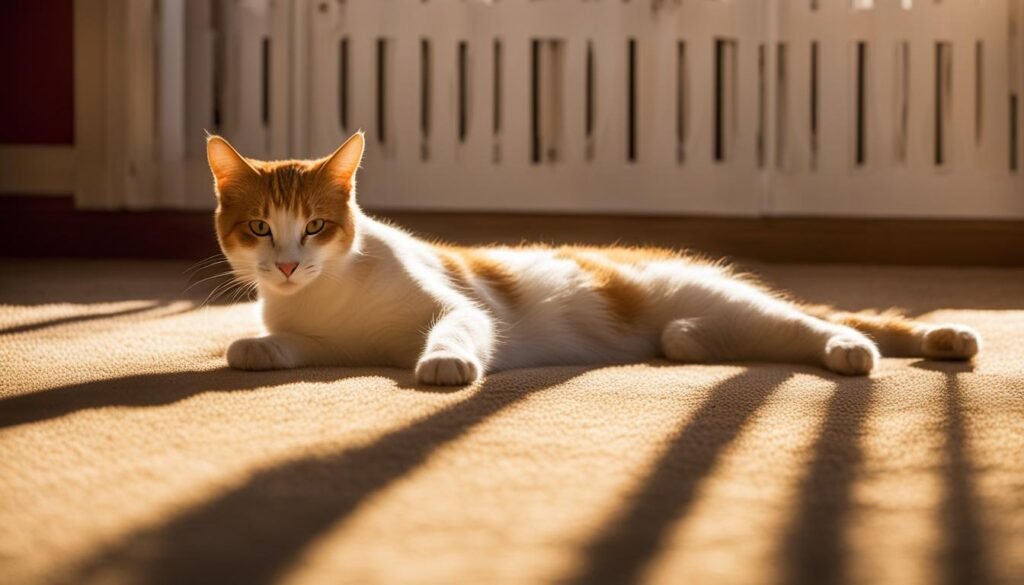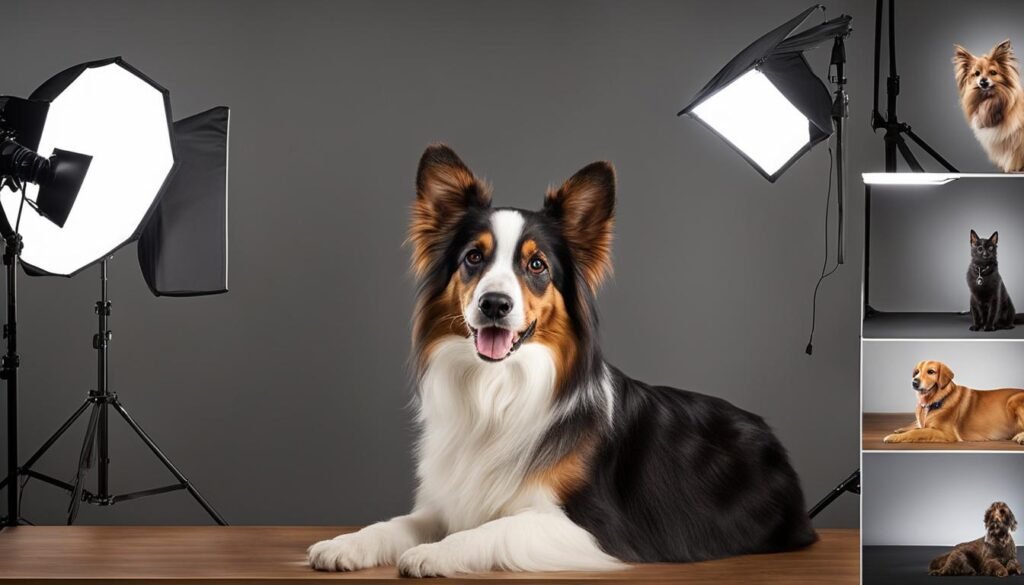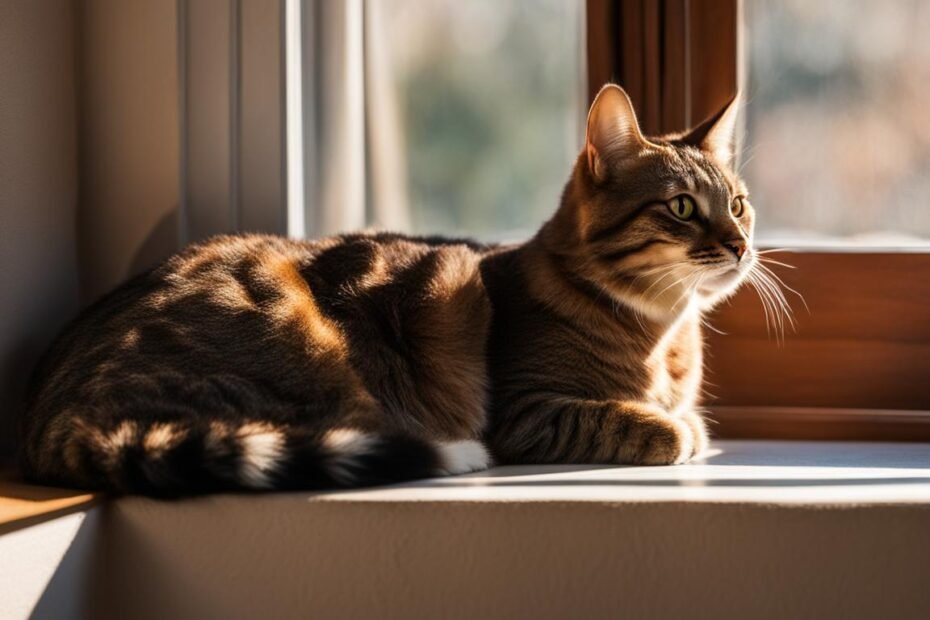Good lighting is crucial for successful cat photography as it impacts the outcome and aesthetic quality of the photographs. Controlling light can make your pets look more beautiful and flattering. Understanding the exposure triangle and mastering the relationship between ISO, shutter speed, and aperture is essential for better control of cat photography. Different types of light, such as hard light and soft light, can be used to create various effects in cat portraits.
Capturing stunning pet portraits requires a deep understanding of lighting techniques specific to cat photography. By mastering cat photography lighting, you can bring out the best in your feline subjects and create images that truly capture their unique personalities. In this article, we will explore the basics of cat photography lighting, different types of light, essential lighting setups and techniques, and valuable tips for achieving beautiful cat photos. Let’s dive in!
Key Takeaways:
- Controlling light is essential for successful cat photography.
- Understanding the exposure triangle is crucial for better control of cat photography lighting.
- Different types of light, such as natural light and artificial light, can be used creatively in cat portraits.
- Mastering various lighting setups and techniques can greatly enhance your cat photography skills.
- Capturing beautiful cat photos requires attention to detail and practicing regularly.
Basics of Cat Photography Lighting and Exposure Triangle
In the world of cat photography, understanding the exposure triangle is essential for capturing stunning feline portraits. The exposure triangle, comprised of ISO, shutter speed, and aperture, controls the amount of light that enters the camera and determines the overall exposure of the photograph. By mastering the relationship between these three elements, photographers can have better control over the lighting in their cat photographs.
The ISO setting determines the sensitivity of the camera’s sensor to light. A higher ISO value allows for shooting in low-light situations but may introduce digital noise to the image. On the other hand, a lower ISO value produces cleaner images but requires more light. Finding the right balance is crucial for achieving optimal cat photography lighting.
Shutter speed refers to the length of time the camera’s shutter remains open, determining how long light is allowed to enter the camera. A faster shutter speed can freeze motion, capturing the playfulness of cats, while a slower shutter speed can create motion blur, adding a sense of movement to the photograph. Experimenting with different shutter speeds can yield creative and dynamic cat portraits.
Aperture controls the amount of light that passes through the camera’s lens. A wider aperture (represented by a smaller f-number) allows more light to enter, resulting in a shallow depth of field and a blurred background. A narrower aperture (represented by a larger f-number) allows less light to enter, resulting in a larger depth of field and a sharper background. Understanding how aperture affects the overall lighting and focus of the image is essential for capturing captivating cat portraits.
| ISO | Shutter Speed | Aperture |
|---|---|---|
| High ISO | Fast Shutter Speed | Wide Aperture |
| Allows shooting in low-light conditions | Freezes motion | Creates a shallow depth of field |
| May introduce digital noise | May result in motion blur | Blurs the background |
| Low ISO | Slow Shutter Speed | Narrow Aperture |
| Produces cleaner images | Adds a sense of movement | Creates a larger depth of field |
| Requires more light | Allows for creative effects | Sharpens the background |
“Understanding the exposure triangle is like having a key to unlocking endless possibilities in cat photography. By manipulating ISO, shutter speed, and aperture, photographers can shape the lighting and overall mood of their cat portraits. It’s a skill that takes time to master, but the results are truly worth it.”
Aspiring cat photographers can find downloadable resources and guides dedicated to mastering the exposure triangle. These materials provide step-by-step instructions, practical tips, and visual examples to help photographers improve their cat photography lighting techniques. Practicing with different lighting scenarios and experimenting with various camera settings will lead to a better understanding of how to achieve perfect exposure and beautifully lit cat portraits.
Now that we have covered the basics of cat photography lighting and the exposure triangle, let’s explore the different types of light that can be used in cat photography in the next section.
Different Types of Light for Cat Photography
When it comes to capturing stunning cat photographs, understanding the different types of light is essential. The right lighting can enhance the beauty of your feline subjects and create captivating portraits. In cat photography, there are three main types of light to consider: natural light, artificial light, and diffused light.
Natural Light
Natural light, such as sunlight or soft light from cloudy days, can produce beautiful and flattering effects in cat portraits. The golden hour, which occurs during sunrise and sunset, provides a warm and soft light that enhances the mood and creates a magical ambiance. Window light is also a great source of natural light to consider when photographing cats indoors. It creates soft shadows and a gentle glow, perfect for capturing the grace and elegance of your feline friends.

Artificial Light
Artificial light, particularly flash photography, can be a useful tool in cat photography. However, it should be used with caution to avoid startling or distressing your subjects. When using artificial light, it’s important to experiment with different techniques to achieve a natural and flattering look. Bouncing the flash off ceilings or walls can help soften the light and create a more diffused effect. This technique reduces harsh shadows and creates a more pleasing overall appearance.
Diffused Light
Diffused light refers to light that has been scattered or softened to create a gentle and even illumination. This type of light is ideal for cat photography as it minimizes harsh shadows and creates a soft and flattering look. There are various ways to diffuse light, such as using reflectors, umbrellas, or softboxes. These tools help spread the light evenly and create a more pleasing and natural lighting effect on your feline subjects.
By understanding and utilizing the different types of light available, you can elevate your cat photography to new levels. Experiment with natural light, explore the possibilities of artificial light, and discover the beauty of diffused light. Each type of light brings its own unique qualities to your photographs, allowing you to capture the essence and personality of your feline companions.
Studio Lighting, Backlighting, Reflectors, Outdoor Lighting, and Indoor Lighting
When it comes to cat photography, choosing the right lighting setup can make a world of difference in capturing stunning portraits of your feline friends. Studio lighting is an excellent option for creating controlled and professional-looking images. With overhead lighting, you can illuminate your cat from above, highlighting their features and creating a unique shadow play. Front lighting, on the other hand, brings out the details in your cat’s face, ensuring every whisker is perfectly lit. Side lighting can create depth and texture, while ring lights provide a soft and even glow.
Another technique that can add a touch of magic to your cat photographs is backlighting. By positioning your subject in front of a light source, such as a window or the sun, you can create a beautiful halo effect around the edges of your cat. This technique adds depth and creates a captivating visual impact.
Reflectors are a valuable tool in cat photography as well. They bounce light back onto your subject, helping to fill in shadows and create a balanced lighting setup. When working with natural light, reflectors can be used to control the intensity and direction of the light, ensuring that your cat is beautifully illuminated.
Whether you’re shooting outdoors or indoors, understanding how to leverage lighting effectively is essential. Outdoor lighting can provide a natural and dynamic backdrop for your cat portraits. Consider capturing your furry friend during golden hour, the period shortly after sunrise or before sunset when the light is warm and flattering. Indoors, you can experiment with different light sources, such as lamps or candles, to create a cozy and intimate atmosphere for your cat photography.
By exploring studio lighting setups, backlighting techniques, using reflectors, and mastering outdoor and indoor lighting, you can take your cat photography to the next level. Experiment with different lighting scenarios to find what works best for your furry models and create captivating portraits that truly showcase their unique personalities.

Tips for Using Studio Lighting in Cat Photography
- Experiment with different lighting angles to create unique and visually engaging compositions.
- Adjust the intensity of the lights to create the desired mood and ambiance in your cat portraits.
- Use diffusers to soften the light and minimize harsh shadows.
Backlighting Techniques for Captivating Cat Portraits
- Position your cat in front of a light source, such as a window or the setting sun, to create a stunning halo effect.
- Experiment with different angles and distances to achieve the desired backlighting effect.
Enhancing Natural Light with Reflectors
- Use reflectors to bounce light onto your subject and fill in shadows for a more balanced and flattering look.
- Experiment with different reflector colors to create different moods and tones in your cat portraits.
Make the Most of Outdoor and Indoor Lighting
- Shoot during the golden hour, shortly after sunrise or before sunset, for warm and beautiful natural lighting.
- Experiment with different light sources indoors, such as lamps or candles, to create a cozy and intimate atmosphere.
Table: Comparing Different Lighting Setups
| Lighting Setup | Features | Best For |
|---|---|---|
| Studio Lighting | Controlled, professional-looking images | Formal or stylized cat portraits |
| Backlighting | Halo effect, depth, and visual impact | Captivating and ethereal cat portraits |
| Reflectors | Fill in shadows, control light direction | Enhancing natural or artificial light sources |
| Outdoor Lighting | Natural and dynamic backdrops | Botanical or outdoor cat photography |
| Indoor Lighting | Cozy and intimate atmosphere | Indoor cat portraits or lifestyle photography |
Tips for Capturing Beautiful Cat Photos with Lighting
When it comes to cat photography, capturing beautiful photos with the right lighting can make all the difference. Whether you’re photographing your feline friend indoors or outdoors, there are several tips and techniques that can help you achieve stunning results. Here are some key tips to keep in mind:
1. Take advantage of sunrise/sunset shots
Sunrise and sunset, also known as the golden hour, provide soft and warm lighting that can add a magical touch to your cat photos. During this time, the angle of the sun is low, creating beautiful, diffused light. Plan your photo sessions around these times to make the most of this natural lighting phenomenon. The golden hour is especially ideal for outdoor cat photography, as it adds a warm glow to your furry friend’s fur.
2. Master low light settings
Cat photography often requires shooting in low light conditions, especially when capturing indoor shots or moody portraits. To ensure sharp and well-exposed photos, adjust your camera settings accordingly. Use a wide aperture to allow more light into the camera sensor, increase the ISO to capture more light sensitivity, and use a slower shutter speed. However, be mindful of camera shake and use a tripod or stabilize your camera to avoid blurriness.
3. Experiment with flash techniques
Using flash in photography can be tricky when it comes to capturing cat portraits. The sudden burst of light can startle your furry subject and result in unflattering photos. However, when used correctly, flash can be a powerful tool to create soft and diffused lighting effects. Instead of directing the flash directly at your cat, try bouncing the light off ceilings or walls to create a more natural and flattering look.
Remember to always acclimate your cat to the flash before the photo session to minimize any potential stress or discomfort.
By following these tips and techniques, you can enhance your cat photography skills and capture stunning portraits of your feline friends. Whether you’re shooting during golden hour, mastering low light settings, or experimenting with flash techniques, the right lighting can transform your cat photos into works of art. So, grab your camera, find the perfect light, and let your creativity shine!
Conclusion
Mastering cat photography lighting is crucial for capturing perfect pet portraits. By understanding the exposure triangle, different types of light, and various lighting setups and techniques, photographers can elevate their cat photography skills and create stunning images that truly showcase the beauty of their feline subjects.
Building a strong pet photography portfolio takes time and dedication. As you progress in your pet photography journey, don’t be discouraged by setbacks. Instead, embrace them as opportunities to learn and grow. Experiment with different lighting techniques, explore new angles, and continuously seek inspiration from other photographers in the field.
Remember, capturing beautiful cat photos is not just about technical skills, but also about connecting with your subjects. Establishing a rapport with the cats and creating a comfortable environment will bring out their unique personalities, resulting in more authentic and captivating images. Pay attention to their behavior, anticipate their movements, and be patient.
For aspiring pet photographers, here are some valuable tips: always be prepared with your camera and equipment, practice regularly to refine your skills, and seek feedback from fellow photographers or mentors. With time, effort, and a genuine passion for pet photography, you can create a portfolio filled with cherished memories and amazing pet portraits that will bring joy to others.
FAQ
Why is good lighting important in cat photography?
Good lighting is crucial for successful cat photography as it impacts the outcome and aesthetic quality of the photographs.
What is the exposure triangle?
The exposure triangle consists of ISO, shutter speed, and aperture, which determine the exposure of a photograph and how light interacts with the camera settings.
What are the different types of light used in cat photography?
Different types of light used in cat photography include natural light, artificial light, and diffused light.
How can I create different lighting effects in cat portraits?
Studio lighting setups, backlighting, and using reflectors are some techniques that can be used to create different moods and effects in pet portraits.
How can I capture beautiful cat photos with lighting?
Taking advantage of the golden hour, understanding low light settings, and using flash techniques can help capture stunning cat portraits.
